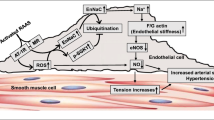Abstract
Cardiovascular risk factors (CVRFs) have been shown to induce end organ damage. Until now, the main approach to reduce CVRF-induced end organ damage was by normalization of CVRFs; this approach was found effective to reduce damage and cardiovascular (CV) events. However, a residual risk always remained even when CVRFs were optimally balanced. An additional risk factor which has an immense effect on the progression of end organ damage is aging. Aging is accompanied by gradual stiffening of the arteries which finally leads to CV events. Until recently, the process of arterial aging was considered as unmodifiable, but this has changed. Arterial stiffening caused by the aging process is similar to the changes seen as a result of CVRF-induced arterial damage. Actually, the presence of CVRFs causes faster arterial stiffening, and the extent of damage is proportional to the severity of the CVRF, the length of its existence, the patient’s genetic factors, etc. Conventional treatments of osteoporosis and of hormonal decline at menopause are potential additional approaches to positively affect progression of arterial stiffening. The new approach to further decrease progression of arteriosclerosis, thus preventing events, is the prevention of age-associated arterial structural changes. This approach should further decrease age-associated arterial stiffening. A totally new promising approach is to study the possibility of affecting collagen, elastin, and other components of connective tissue that participate in the process of arterial stiffening. Reduction of pulse pressure by intervention in arterial stiffening process by novel methods as breaking collagen cross-links or preventing their formation is an example of future directions in treatment. This field is of enormous potential that might be revolutionary in inducing further significant reduction of cardiovascular events.
Similar content being viewed by others
References
Papers of particular interest, published recently, have been highlighted as: • Of importance
Benetos A, Laurent S, Hoeks AP, Boutouyrie PH, Safar ME. Arterial alterations with aging and blood pressure. A noninvasive study of carotid and femoral arteries. Arterioscler Thromb. 1993;13:90–7.
Lakatta EG. Cardiovascular regulatory mechanism in advanced age. Physiol Rev. 1993;73:413–67.
Virmani R, Avolio AP, Mergner WJ, et al. Effect of aging on aortic morphology in populations with high and low prevalence of hypertension and atherosclerosis. Comparison between occidental and Chinese communities. Am J Pathol. 1991;139:1119–29.
Najjar SS, Scuteri A, Lakatta EG. Arterial aging is it an immutable cardiovascular risk factor. Hypertension. 2005;46:454–62.
Laurent S, Lacolley P, Girerd X, et al. Arterial stiffening opposing effects of age and hypertension associated structural changes. Can J Physiol Pharmacol. 1996;74:842–9.
Vlachopoulos C, Aznaouridis K, O’Rourke MF, et al. Prediction of cardiovascular events and all-cause mortality with central hemodynamics: a systematic review and meta–analysis. Eur Heart J. 2010;31:1865–71.
Sethi S, Rivera O, Oliveros R, et al. Aortic stiffness: pathophysiology, clinical implications, and approach to treatment. Integr Blood Press Control. 2014;7:29–34. A review that focuses on the pathophysiology involved in aortic stiffness, methods of its evaluation, the importance of central pressure and therapeutic approach to arterial stiffening.
Laurent S, Cockroft J, Van Bortel L, et al. Expert consensus document on arterial stiffness: methodological issues and clinical applications. Eur Heart J. 2006;2:2558–605.
Boutouryie P, Lacolley P, Briet M, et al. Pharmacological modulation of arterial stiffness. Drugs. 2011;71:1689–701.
Ong KT, Delerme S, Pannier B, et al. Aortic stiffness is reduced beyond blood pressure lowering by short term and long term antihypertensive treatment: a meta–analysis of individual data in 294 patients. Hypertension. 2011;29:1034–42.
Boutouyrie P, Achouba A, Trunet P, Laurent S, EXPLOR trialist group. Amlodipine–valsartan combination decreases central systolic blood pressure more effectively than the amlodipine–atenolol combination: the EXPLOR study. Hypertension. 2010;55:1314–22.
Laurent S, Boutouryie P. Recent advances in arterial stiffness and wave reflection in human hypertension: hypertension highlights. Hypertension. 2007;49:1202–6.
Tropeano AI, Boutouryie P, Pannier B, et al. Brachial pressure independent reduction in carotid stiffness after long term angiotensin converting enzyme inhibition in diabetic hypertensives. Hypertension. 2006;48:80–6.
Benetos A, Locolley P, Safar MF. Prevention of aortic fibrosis by spironolactone in spontaneously hypertensive rats. Arterioscler Thromb Vasc Biol. 1997;17:1152–6.
Safar ME, London GM. The arterial system in human hypertension. In Swales J D ed. Textbook of Hypertension, London UK: Blackwell Scientific: 1994: 85–102.
Nilsson PM, Boutouryie P, Cunha P, et al. Early vascular aging in translation: from laboratory investigations to clinical applications in cardiovascular prevention. J Hypertens. 2013;31:1517–26. A comprehensive review that summarizes early vascular ageing and how it can be used in clinical practice.
Rizos EC, Agouridis AP, Elisaf MS. The effect of statin therapy on arterial stiffness by measuring pulse wave velocity: a systematic review. Curr Vasc Pharmacol. 2010;8:638–44.
Nilsson PM, Boutouryie P, Laurent S. Vascular aging a tale of EVA and ADAM in cardiovascular risk assessment and prevention. Hypertension. 2009;54:3–10.
Rajkumar C, Kingwell BA, Cameron JD, et al. Hormonal therapy increases arterial compliance in postmenopausal women. J Am Coll Cardiol. 1997;30:350–6.
Wagenseil JE, Mecham RP. Elastin in large artery stiffness and hypertension. J Cardiovasc Transl Res. 2012;5:264–73. A review that discusses how alterations in the properties of elastic fibers affect arterial stiffness and blood pressure.
Ponticos M, Smith BD. Extracellular matrix synthesis in vascular disease: hypertension and atherosclerosis. J Biomed Res. 2014;28:25–39. A review that summarizes the cellular, extracellular matrix components and the regulation of collagen with their implications on vascular disease.
Compliance with Ethics Guidelines
Conflict of Interest
Reuven Zimlichman declares that he has no conflict of interest.
Human and Animal Rights and Informed Consent
This article does not contain any studies with human or animal subjects performed by any of the authors.
Author information
Authors and Affiliations
Corresponding author
Additional information
This article is part of the Topical Collection on Hypertension and Obesity
Rights and permissions
About this article
Cite this article
Zimlichman, R. Treatment of Hypertension and Metabolic Syndrome: Lowering Blood Pressure Is Not Enough for Organ Protection, New Approach-Arterial Destiffening. Curr Hypertens Rep 16, 479 (2014). https://doi.org/10.1007/s11906-014-0479-z
Published:
DOI: https://doi.org/10.1007/s11906-014-0479-z



